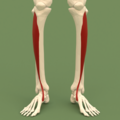Anterior compartment of leg
Anterior compartment of leg refers to one of the anatomical compartments in the lower leg, housing muscles that primarily facilitate dorsiflexion of the foot and extension of the toes. This compartment is significant not only for its role in locomotion but also in various medical conditions, such as compartment syndrome.
Anatomy[edit]
The anterior compartment is bounded by the tibia and fibula bones medially and laterally, respectively, the anterior intermuscular septum, and the deep fascia of the leg. It is one of the four compartments in the lower leg, the others being the lateral, superficial posterior, and deep posterior compartments.
Muscles[edit]
The anterior compartment contains the following muscles:
- Tibialis anterior: Responsible for dorsiflexion and inversion of the foot.
- Extensor hallucis longus: Extends the big toe and assists in dorsiflexion of the foot.
- Extensor digitorum longus: Extends the toes and assists in dorsiflexion of the foot.
- Peroneus tertius (also known as fibularis tertius): Assists in dorsiflexion and eversion of the foot.
These muscles are innervated by the deep peroneal nerve, and the blood supply comes from the anterior tibial artery.
Function[edit]
The primary function of the anterior compartment muscles is to facilitate the dorsiflexion of the foot at the ankle joint and extension of the toes. This action is crucial for the 'heel strike' and 'foot flat' phases of the gait cycle, allowing for smooth transition and propulsion of the body forward during walking and running.
Clinical Significance[edit]
- Compartment Syndrome###
The anterior compartment is susceptible to compartment syndrome, a condition where increased pressure within the compartment compromises blood flow and nerve function, potentially leading to muscle and nerve damage. Acute compartment syndrome is a medical emergency, often caused by trauma, requiring immediate intervention to prevent permanent damage.
- Shin Splints###
Shin splints is a term often used to describe pain along the tibia, which can be associated with overuse injuries affecting the anterior compartment muscles. Proper rest, physiotherapy, and gradual return to activity are key to management.
Diagnosis and Treatment[edit]
Diagnosis of conditions affecting the anterior compartment often involves a combination of clinical examination, imaging studies such as MRI or ultrasound, and compartment pressure testing for compartment syndrome. Treatment varies from conservative management, such as rest and physiotherapy, to surgical interventions like fasciotomy for compartment syndrome.
See Also[edit]
-
Tibialis anterior
-
Extensor hallucis longus
-
Extensor digitorum longus
-
Fibularis tertius
-
Animation of anterior compartment of leg
Ad. Transform your life with W8MD's Budget GLP-1 injections from $75


W8MD offers a medical weight loss program to lose weight in Philadelphia. Our physician-supervised medical weight loss provides:
- Weight loss injections in NYC (generic and brand names):
- Zepbound / Mounjaro, Wegovy / Ozempic, Saxenda
- Most insurances accepted or discounted self-pay rates. We will obtain insurance prior authorizations if needed.
- Generic GLP1 weight loss injections from $75 for the starting dose.
- Also offer prescription weight loss medications including Phentermine, Qsymia, Diethylpropion, Contrave etc.
NYC weight loss doctor appointmentsNYC weight loss doctor appointments
Start your NYC weight loss journey today at our NYC medical weight loss and Philadelphia medical weight loss clinics.
- Call 718-946-5500 to lose weight in NYC or for medical weight loss in Philadelphia 215-676-2334.
- Tags:NYC medical weight loss, Philadelphia lose weight Zepbound NYC, Budget GLP1 weight loss injections, Wegovy Philadelphia, Wegovy NYC, Philadelphia medical weight loss, Brookly weight loss and Wegovy NYC
|
WikiMD's Wellness Encyclopedia |
| Let Food Be Thy Medicine Medicine Thy Food - Hippocrates |
Medical Disclaimer: WikiMD is not a substitute for professional medical advice. The information on WikiMD is provided as an information resource only, may be incorrect, outdated or misleading, and is not to be used or relied on for any diagnostic or treatment purposes. Please consult your health care provider before making any healthcare decisions or for guidance about a specific medical condition. WikiMD expressly disclaims responsibility, and shall have no liability, for any damages, loss, injury, or liability whatsoever suffered as a result of your reliance on the information contained in this site. By visiting this site you agree to the foregoing terms and conditions, which may from time to time be changed or supplemented by WikiMD. If you do not agree to the foregoing terms and conditions, you should not enter or use this site. See full disclaimer.
Credits:Most images are courtesy of Wikimedia commons, and templates, categories Wikipedia, licensed under CC BY SA or similar.
Translate this page: - East Asian
中文,
日本,
한국어,
South Asian
हिन्दी,
தமிழ்,
తెలుగు,
Urdu,
ಕನ್ನಡ,
Southeast Asian
Indonesian,
Vietnamese,
Thai,
မြန်မာဘာသာ,
বাংলা
European
español,
Deutsch,
français,
Greek,
português do Brasil,
polski,
română,
русский,
Nederlands,
norsk,
svenska,
suomi,
Italian
Middle Eastern & African
عربى,
Turkish,
Persian,
Hebrew,
Afrikaans,
isiZulu,
Kiswahili,
Other
Bulgarian,
Hungarian,
Czech,
Swedish,
മലയാളം,
मराठी,
ਪੰਜਾਬੀ,
ગુજરાતી,
Portuguese,
Ukrainian




